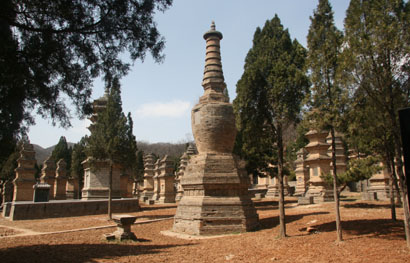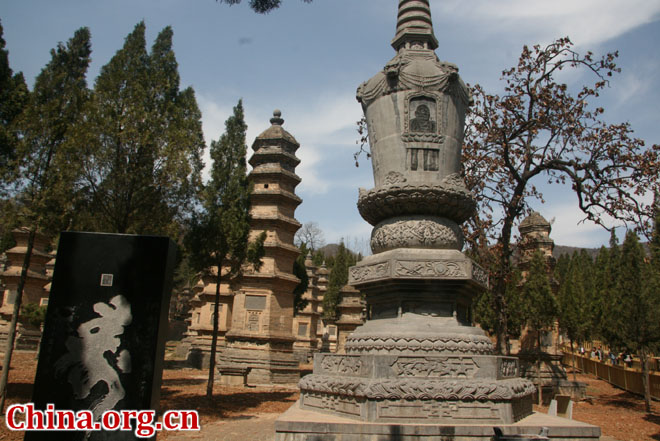Pagoda Forest in Shaolin Temple

 0 Comment(s)
0 Comment(s) Print
Print E-mail China.org.cn, March 28, 2012
E-mail China.org.cn, March 28, 2012

The pagoda forest in Shaolin Temple was a concentration of tomb pagodas for eminent monks, abbots and ranking monks at the temple. A rough count shows more than two hundred fifty tomb pagodas of various sizes, making it the biggest pagoda forest in China.
The forest stands at the foot of Shaoshi Mountain about half a kilometer west of Shaolin Temple and is composed of pagodas dating from 791 to 1803. Most are stone and brick structures of one to seven storeys, under fifteen meters high--much smaller than pagodas for Buddhist relics--but they all carry the exact year of their construction and many carvings and inscriptions. They are in a variety of styles, but are mainly multi-eaved and pavilion-style. Their shapes are varied, including polygonal, cylindrical, vase, conical and monolithic, making the pagoda forest an exhibition of ancient pagodas, carvings and calligraphy of various dynasties.
Here also lie the remains and traces of the activities of some eminent foreign monks. For example, in the eastern part of the forest a tomb pagoda built in 1339 in the Yuan Dynasty bears an epitaph written by a Japanese monk at Shaolin Temple, which is of elegant language and excellent handwriting. In the western part of the forest is a tomb pagoda built in 1564 in the Ming Dynasty for an Indian monk.
Besides the pagoda forest there are many invaluable tomb pagodas scattered around Shaolin Temple. They include Faro Pagoda and Tongguang Pagoda, built in 689 and 771 in the Tang Dynasty, Tongguang Pagoda, constructed in 926 in the Five Dynasties, and Yuangong Pagoda, erected in 1324 in the Yuan Dynasty, which are gems among ancient pagodas.






Go to Forum >>0 Comment(s)